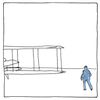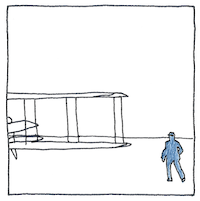Wilbur Wright, Orville Wright
aerodynamics

|
Airplane
Wilbur and Orville Wright demonstrated the first heavier-than-air powered sustained controlled flight on 17 December 1903.
Toy helicopter
Alphonse Pénaud was the first to power a model flying machine with a rubber band. In 1870, his helicopter featured two counter-rotating propellers with leaf-like blades, one above and one below the spinning rubber band. In 1878, the Wright brother’s father gave them one and they began to build their own. They called them bats and dreamed of building one big enough to carry them both.
Kites and gliders
Considering a kite sailing in the air, Wilbur figured the tension on the kite string was the sum of its lift and drag— the lift pulling vertically against gravity, the drag horizontally along with the wind— and the angle of the string directly reflected the balance of forces. The brothers measured wind speed using a French, hand-held anemometer. They measured the tension of the kite string using a spring scale tied to the line and measured the angle using a surveyor’s inclinometer. With the tension and the angle, Wilbur calculated the lift and drag of this triangle of forces using elementary trigonometry. This is why at Kitty Hawk they flew their gliders as kites. Instead of risking their lives from the top of a hill, they could calculate lift and drag of their machines in flight and thereby tell whether it performed as they expected— whether it would support a man in flight.
Controls
The Wright brothers realized Lilienthal had died in 1896 because he couldn’t control his glider. They studied birds in flight. Soaring birds adjusted roll, pitch, and yaw with graceful shifts of wing and tail. Roll, pitch, and yaw skewed a glider dangerously in flight. One by one, the brothers developed mechanisms and skills to control their path in flight. * When a bird elevates its tail its body tilts up. On their flyer, the Wright brothers placed the elevators two movable horizontal wings in front of the wings. * To roll, birds adjust their wings like the vanes of a windmill. How to do this with a biplane was unclear when the mechanism had to be both simple and light until Wilbur, absent-minded, squeezed opposite corners of a slim inner-tube box and noticed that squeezing one way tilted the right side up and the left side down, while squeezing opposite corners reversed the warping. With a set of cables the brothers could twist the wings of their glider to roll either way to control lateral movements. Warping the wings acted on exactly the same principle as raising and lowering ailerons on opposite fixed wings. * Warping wings to steer into the wind, their glider tended to skid to the side. The wing with the highest angle of attack presented more surface to the wind, which skewed the flyer away from their intended turn, so the brothers replaced the fixed tail with a rudder rigged to turn in the opposite direction of the yaw. * Warping the wings controlled the roll. Moving the elevator controlled the pitch. Turning the rudder controlled the yaw.
Data
Their 1901 glider did not produce the lift the brothers thought it should during their tests at Kitty Hawk, so they began to doubt Otto Lilienthal’s lift and drag data. * To separate lift from drag George Spratt had suggested a simple apparatus. The brothers attached a horizontal wheel at the front of a bicycle and on this wheel they mounted a curved plane, a miniature wing, and ninety degrees from the wing they mounted a flat plane. They set the wing at the angle of incidence indicated by Lilienthal and they set the flat plane perpendicular to direction of movement. Lilienthal’s data showed that lift should equal drag so that the lift of the curved wing should balance the drag from the flat plane, but, peddling to get their wind, drag exceeded lift and the wheel turned instead of balancing in the wind. * To more accurately test Lilienthal’s data, they built a wind tunnel and developed testing techniques. They invented a balance to accurately determine the lift and drag of their miniature wings. With the wind tunnel they discovered that Lilienthal’s data was nearly correct but John Smeaton’s coefficient of air pressure, which Lilienthal used to calculate lift, was way off. * The camber of Lilienthal’s wing was the section of a circle. Using their wind tunnel, the Wrights found a parabolic section provided better lift.
Wing
The Wright brothers called their flying machine a flyer and they called its wings aeroplanes, the word being derived from ancient Greek meaning “wandering in the air,” so we now name the airplane after its wings.
Propeller
Since nothing on a flyer stood still it was difficult to imagine how to make a propeller. “It was apparent,” the brothers realized, “that a propeller was simply an aeroplane traveling in a spiral course.” after hatchet and hacksaw they made a propeller whose cross section was curved like a wing.
Engine
An engine for the Wright flyer had to be both powerful and light. They were not able to buy an engine that weighed 180 pounds or less and delivered at least 8 horsepower, so, with Charlie Taylor, they made their own, a four-cylinder water-cooled engine with an aluminum crankcase that produced 12 horsepower.
Instability
The Wright brothers knew a bicycle without a skilled rider and a means to steer was laterally unstable. No rider, no pilot can walk, let alone run, without temporarily tilting his or her body out of balance. No reason to suppose a flying machine would differ except in having more dimensions of instability.
Commercial
Commercial airlines take the magic out of flight. Too fast, too high, too protected from the wind. A good thing to serve the needs of a corporation. But I’ll make a kite; I’ll find plans for a glider and make my own. If I work hard, maybe I’ll discover the incantation and there’ll be no seat belt or air bag on my magic carpet.
Dreams of flying
indicate overreaching trying something risky something trying to strain the shackles expand the boundaries and the possibility of failure. One seldom fails in dreams though often for real and must continue to dream.



Wilbur and Orville Wright were scientists as well as inventors. They were the first to measure the performance of a full-sized flying machine in flight. They built their wind tunnel to test the results of Otto Lilienthal for understanding lift and drag, and corrected the coefficient of air pressure that Lilienthal used, 0.005, given by John Smeaton. The correct value is 0.00327; the Wright brothers derived the value of 0.033.
See also in The book of science:
Readings in wikipedia:
Other readings: